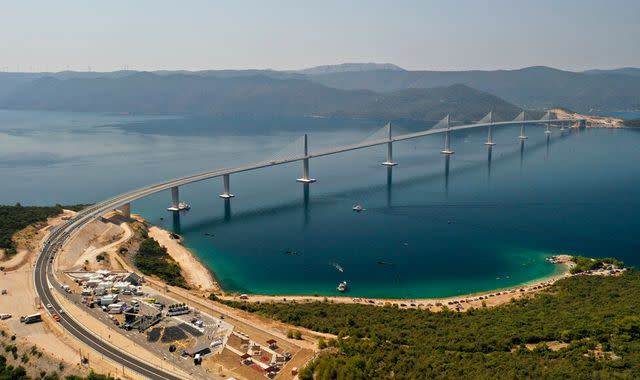Bridge connecting Croatia's mainland to southern peninsula opens

A long-awaited bridge connecting two parts of the Adriatic Sea coastline in Croatia has officially opened on Tuesday, in what has been hailed a "historic day" for generations of people.
The 2.4km (1.5 mile) structure links the mainland to the Peljesac peninsula in the south, enabling easier access to the city of Dubrovnik, the country's biggest tourist attraction.
The two parts of Croatia's Adriatic Sea coastline were split by a narrow strip of Bosnia when the Yugoslav Federation broke up in the early 1990s.
Until then it had no internal borders between its six republics, including Bosnia and Herzegovina, Croatia, Macedonia, Montenegro, Serbia and Slovenia.
But the split saw residents and tourists required to pass border checks, slowing traffic and leaving people in southern Croatia isolated from the rest of the country - including Dubrovnik, which is on Unesco's protected heritage list.
Now the bridge will bypass the small section of Bosnian territory.
Hundreds of people rushed to be among the first to cross the bridge on foot after it was formally opened, initially to pedestrians and then to motorists.
The opening was described as a "historic day that generations awaited" on state HRT television.
Prime Minister Andrej Plenkovic said: "This is a big day for Croatia. Let's enjoy it today!"
The cable-stayed bridge, which has six pylons, became a reality in 2017 when the EU earmarked €357m (£300m) towards the project, which cost a total of €526m (£444m).
It was built by the China Road and Bridge Corporation which won an international tender in 2018, despite concerns over Beijing's attempts to boost its economic influence through investment in infrastructure.
However, the bridge has attracted criticism from Bosnian officials over apparent unresolved border issues and concerns it could hamper access to their part of the coastline.
Tourism is critical for Croatia's economy, which remains among the weakest in the EU.
The country is poised to clear the final obstacles for adopting the euro, paving the way for it to become the 20th member of the eurozone from January next year.
If successful, it will mean any of the 340 million eurozone inhabitants who visit Croatia will no longer need to exchange their cash for Croatian kuna.


